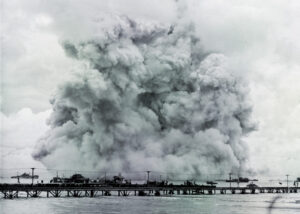Mutiny at Fort Jackson: The Untold Story of the Fall of New Orleans
by Michael D. Pierson, University of North Carolina Press, 2008, $30
After shattering a rickety Confederate fleet on April 24, 1862, Union Admiral David G. Farragut’s warships slipped up the Mississippi River past the booming guns of Forts Jackson and St. Philip and closed on New Orleans, one of the keys to controlling the mighty river. Three nights later, Rebel mutineers at Fort Jackson did what the Federal shells had not— silenced the two forts. Confederate officers subsequently surrendered both, rendering the Crescent City all but defenseless.
Studies of this act of treason have been few and cursory. Who were the mutineers? What drove them to forsake their fledgling country? And what did their actions say about the real state of affairs in New Orleans and across much of the South? Michael D. Pierson strives to answer these questions, and more, in Mutiny at Fort Jackson: The Untold Story of the Fall of New Orleans.
After setting the scene around New Orleans one year into the Civil War, Pierson contrasts self-serving Union explanations for the mutiny with the testimony of Fort Jackson’s commanders. These men believed that the mutineers simply “felt no attachment to the southern republic,” he writes.
Following that thread, Pierson focuses on the recruiting pool and labor relations around economically troubled New Orleans and the differences between Confederate Regulars and the largely German and Irish mutineers—whose views on slavery and freedom often clashed. Pierson claims that the events at Fort Jackson, and in other similar Confederate outposts, indicate not only that Rebel soldiers “did not uniformly support their government when the chips were down,” but that there was also “a larger movement within the Confederate military to resist its elitist and xenophobic government.”
Pierson re-examines perceptions of Maj. Gen. Benjamin Butler, the politician-turned-commander who was first charged with running occupied New Orleans. Despised for imposing martial law, Butler nevertheless proved a capable administrator, coupling heavy-handed discipline with charity and wide-ranging employment efforts to stabilize the city and draw disaffected Southerners back into the old Union.
Hatred of the man dubbed “the Beast,” Pierson finds, “had its roots in Butler’s ability to prove the single most damaging thing that could be said about the Confederacy: it did not enjoy the unanimous support of the white South.”
This compelling, sometimes poignant account reflects exhaustive research on the author’s part, but by quietly touching on the mutiny early and then setting it aside until much later, Pierson costs his narrative significant momentum. The book might have benefited if its chapters had been shuffled.
Pierson’s examination of Union support in this Rebel stronghold illuminates broad thinking about Southern society, even modern America: “The Confederacy envisioned by people today,” Pierson says, “represents poor, decent (white) people resisting an oppressive and entitled government. What happened in Fort Jackson and in New Orleans points to a different idea of what the Confederacy was all about.”
Originally published in the January 2009 issue of America’s Civil War. To subscribe, click here.




